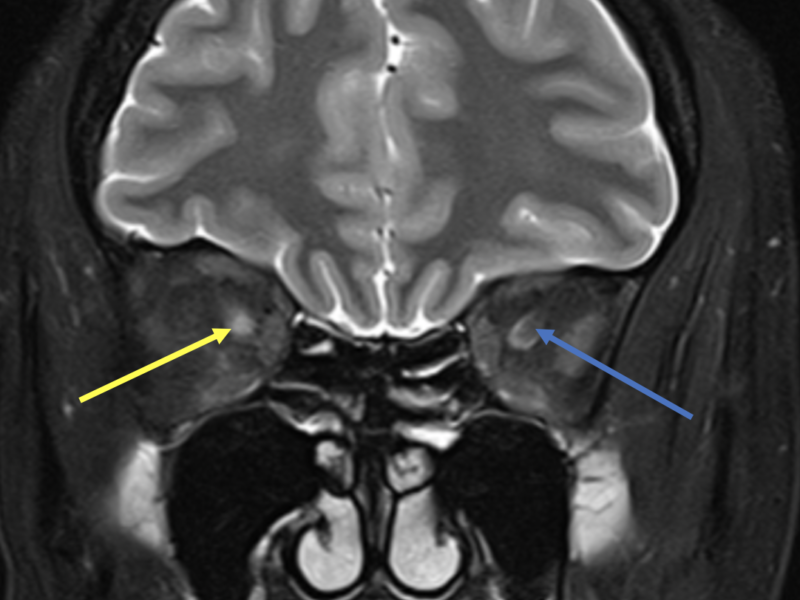

Front Hum Neurosci 2021 15:782490.įujimori J, Ogawa R, Murata T, et al. Myelin oligodendrocyte glycoprotein antibody associated cerebral cortical encephalitis: case reports and review of literature. Clinical analysis of adult MOG antibody‐associated cortical encephalitis. Unilateral cortical FLAIR‐hyperintense lesions in anti‐MOG‐associated encephalitis with seizures (FLAMES): characterization of a distinct clinico‐radiographic syndrome.

Neurol Neuroimmunol Neuroinflamm 2017 4:e322.īudhram A, Mirian A, Le C, et al. MOG antibody‐positive, benign, unilateral, cerebral cortical encephalitis with epilepsy. Ogawa R, Nakashima I, Takahashi T, et al. Follow‐up imaging 18 months later reveals resolution of right temporal lobe cortical swelling, T2 hyperintensity, and enhancement with new left temporal T2 hyperintensity (C3, yellow bracket) with subtle leptomeningeal enhancement although slightly limited by motion artifact (C4, yellow bracket ) in a patient with recurrent cerebral cortical encephalitis attacks. (C) Axial FLAIR image reveals right temporal lobe cortical T2 hyperintensity and swelling (C1, yellow bracket) with T1‐weighted postgadolinium image revealing accompanying leptomeningeal enhancement (C2, yellow bracket ). (B) Axial FLAIR image reveals left parietal cortical T2 hyperintensity and swelling (B1, yellow bracket), and T1‐weighted postgadolinium image reveals concomitant subtle leptomeningeal enhancement (B2 ). (T) CD35 immunohistochemistry shows absence of follicle dendritic cells. (S) The staining for the proliferation marker, Ki67, reveals no proliferating activity in the B‐cell aggregates. (R) CD20 immunohistochemistry shows B‐cell abundant aggregates present in the leptomeninges. (P, Q) CD4+ (P) and CD8+ (Q) lymphocytes are both present in the subarachnoid space. (O) CD68 stain highlights extensive macrophage/microglial reactivity in both meninges and subpial lesions. (N) Left hemispheric cortical biopsy using the PLP stain shows extensive subpial cortical demyelination (indicated with arrows) with marked meningeal inflammatory infiltration. (M) Axial FLAIR images reveal cortical T2 hyperintensity and swelling in the left hemispheric cortex. (L) Axial T1‐weighted postgadolinium MRI shows cortical and leptomeningeal enhancement. (K) Axons are preserved with mild perivascular spheroid formation (indicated with arrow). (J) No C9 neoantigen (terminal complement activation product) is present. (I) Extensive microglial reactions are present beyond the demyelination in the cortex. (G, H) Immunohistochemistry reveals perivascular infiltration of both CD4+ (G) and CD8+ (H) T lymphocytes. (F) Hematoxylin and eosin (H&E) stain shows mild perivascular infiltration and edema.

(C–E) The enlarged views of framed region in B show perivascular myelin loss to an equal extent in PLP (C), MOG (D), and myelin‐associated glycoprotein (MAG E). (B) Cortical biopsy of the right temporal lobe in this patient shows diffuse subpial cortical demyelination ( arrows) and small perivascular intracortical demyelination within the frame (proteolipid protein immunohistochemistry). (A) The axial MRI fluid‐attenuated inversion recovery (FLAIR) image shows swelling and T2 hyperintensity in the right more than left cortex and in subcortical white matter. The magnetic resonance imaging (MRI) and pathology of 2 patients with myelin oligodendrocyte glycoprotein (MOG) antibody‐associated disease cerebral cortical encephalitis. Annals of Neurology published by Wiley Periodicals LLC on behalf of American Neurological Association. This study highlights the CCE spectrum and provides insight into its pathogenesis. Most received high-dose steroids (n = 17, 89%), and all improved, but 3 had CCE relapses.

CCE pathology (n = 2) showed extensive subpial cortical demyelination (n = 2), microglial reactivity (n = 2), and inflammatory infiltrates (perivascular, n = 1 meningeal, n = 1). N-Methyl-D-aspartate receptor autoantibodies coexisted in 2 of 15 tested (13%). Magnetic resonance imaging revealed unilateral (n = 12, 63%) or bilateral (n = 7, 37%) cortical T2 hyperintensity and leptomeningeal enhancement (n = 17, 89%). In this observational retrospective study, we characterized 19 CCE patients (6.7% of our MOGAD cohort). Cerebral cortical encephalitis (CCE) is a recently described myelin oligodendrocyte glycoprotein antibody-associated disease (MOGAD) phenotype.


 0 kommentar(er)
0 kommentar(er)
